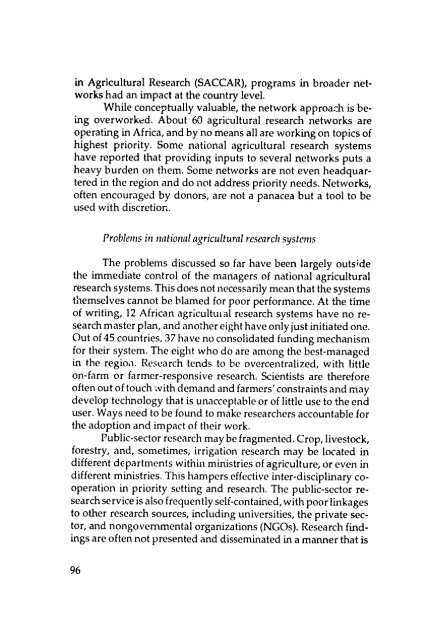Survival in the Sahel
Survival in the Sahel
Survival in the Sahel
Create successful ePaper yourself
Turn your PDF publications into a flip-book with our unique Google optimized e-Paper software.
<strong>in</strong> Agricultural Research (SACCAR), programs <strong>in</strong> broader networks<br />
had an impact at <strong>the</strong> country level.<br />
While conceptually valuable, <strong>the</strong> network approach is be<strong>in</strong>g<br />
overworked. About 60 agricultural research networks are<br />
operat<strong>in</strong>g <strong>in</strong> Africa, and by no means all are work<strong>in</strong>g on topics of<br />
highest priority. Some national agricultural research systems<br />
have reported that provid<strong>in</strong>g <strong>in</strong>puts to several networks puts a<br />
heavy burden on <strong>the</strong>m. Some networks are not even headquartered<br />
<strong>in</strong> <strong>the</strong> region and do not address priority needs. Networks,<br />
often encouraged by donors, are not a panacea but a tool to be<br />
used with discretion.<br />
Problems <strong>in</strong> nationalagriculturalresearchsystems<br />
The problems discussed so far have been largely outside<br />
<strong>the</strong> immediate control of <strong>the</strong> managers of national agricultural<br />
research systems. This does not necessarily mean that <strong>the</strong> systems<br />
<strong>the</strong>mselves cannot be blamed for poor performance. At <strong>the</strong> time<br />
of writ<strong>in</strong>g, 12 African agricultuial research systems have no research<br />
master plan, and ano<strong>the</strong>r eight have only just <strong>in</strong>itiated one.<br />
Out of 45 countries, 37 have no consolidated fund<strong>in</strong>g mechanism<br />
for <strong>the</strong>ir system. The eight who do are among <strong>the</strong> best-managed<br />
<strong>in</strong> <strong>the</strong> regioa. Research tends to be overcentralized, with little<br />
on-farm or farmer-responsive research. Scientists are <strong>the</strong>refore<br />
often out of touch with demand and farmers' constra<strong>in</strong>ts and may<br />
develop technology that is unacceptable or of little use to <strong>the</strong> end<br />
user. Ways need to be found to make researchers accountable for<br />
<strong>the</strong> adoption and impact of <strong>the</strong>ir work.<br />
Public-sector research may be fragmented. Crop, livestock,<br />
forestry, and, sometimes, irrigation research may be located <strong>in</strong><br />
different departments with<strong>in</strong> m<strong>in</strong>istries of agriculture, or even <strong>in</strong><br />
different m<strong>in</strong>istries. This hampers effective <strong>in</strong>ter-discipl<strong>in</strong>ary cooperation<br />
<strong>in</strong> priority sett<strong>in</strong>g and research. The public-sector research<br />
service is also frequently self-conta<strong>in</strong>ed, with poor l<strong>in</strong>kages<br />
to o<strong>the</strong>r research sources, <strong>in</strong>clud<strong>in</strong>g universities, <strong>the</strong> private sector,<br />
and nongovernmental organizations (NGOs). Research f<strong>in</strong>d<strong>in</strong>gs<br />
are often not presented and dissem<strong>in</strong>ated <strong>in</strong> a manner that is<br />
96

















